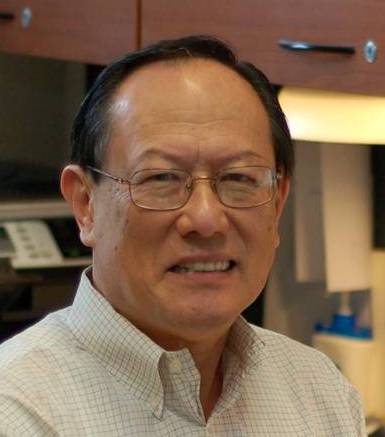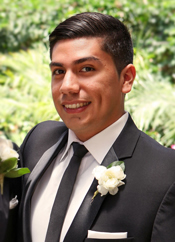November 2014 Newsletter: Volume 1, Issue 4
A Message From the Director, Jian-Ping Wang
Welcome to the 4th C-SPIN Quarterly Newsletter. In this newsletter, we have an excellent Q&A with our Theme 1 leader, Dr. Chia-Ling Chien about perpendicular magnetic materials and spin device research, two of the keys to the success of C-SPIN. For me, the work done in these areas over the past two years shows how dynamic our C-SPIN research is and how it leads us (and our industry sponsors) in exciting new research directions. Thanks to Mike Lotti for his efforts to put the Newsletter together.
Annual review in September. The Annual Review was the most important event in the second year of the Center. Thanks to the representatives from our sponsors for flying to Minneapolis and looking into the research achievements and challenges of C-SPIN. Also thanks for all our Theme leaders, PIs, and all of the students and postdocs for putting together a comprehensive summary of C-SPIN research. I would like to thank Marie and Sylvia for their great effort arranging all the logistics things for a smooth annual review.
I was pleased to see, once again, the excellent work of C-SPIN students/postdocs through posters and presentations at the Open House. I am also proud that these students and postdocs organized a wonderful tutorial session themselves during the last day of review.
The review also provided a golden opportunity for PIs to have fruitful face-to-face breakout sessions that were dedicated to discussing new research directions and ways they can work together efficiently on several topics. We are still digesting all the suggestions and comments from our sponsors, which will help us better align our resources for the next three years.
C-SPIN Distinguished Industry Associates. We proudly announced two C-SPIN Distinguished Industry associates for 2014: Dr. Steve Kramer from Micron and Dr. Behtash Behin-Aein from GLOBLFOUNDRIES. We appreciate their dedication to C-SPIN, especially their timely feedback when we've asked about research and industry perspectives throughout the year. Regular engagement with industry sponsors, especially specific scientific discussions and feedback, is on the top in my work list for 2015.
 Prof. Chia-Ling Chien
Prof. Chia-Ling ChienQ&A with Chia-Ling Chien, Leader of Theme 1
Q: What has Theme 1 learned about materials with perpendicular magnetic anisotropy (PMA) since C-SPIN began in January 2013?
Chien: First of all, we’ve learned that we were right to focus on PMA from the very beginning. Every PMA device we’ve worked with is far superior to devices with in-plane anisotropy in terms of the spin transfer torque (STT) required for switching and the ability to put devices close to each other with minimal cross talk. We’ve also learned that it’s not easy to make PMA materials. Processing of bulk PMA usually requires higher annealing temperatures than the industry limit of 400ºC. Jian-Ping Wang has developed a method for annealing at 350ºC, but it’s not clear yet whether these PMA materials can lead to large MR. The big discovery, though, has been voltage-controlled magnetic anisotropy and magnetism in Co/GdO by Geoffrey Beach and Weigang Wang. Following a discovery by Geoffrey Beach that voltage could alter the magnetic anisotropy of Co in contact with GdO from in-plane to PMA, Weigang showed, using XMCD, that the voltage actually alters the Co magnetism. It’s hard to stress enough what a breakthrough this is - no one even considered it possible a few years ago. Needless to say, people in C-SPIN and elsewhere are trying to figure out ways to exploit this.
Q: What research has been done to understand spin current better?
Chien: We've known for a long time that spin current is difficult to generate and to detect. Some materials (like platinum) are more efficient than others (like copper) in converting charge current to spin current and vice versa. The key, then, is to find materials that are super-efficient in the conversion, i.e. with a very large spin Hall angle. But finding such materials is a daunting task because there are so many elements and alloys out there, and there is no agreed-upon method for measuring spin Hall angle. When you look at the literature, the methods and numbers are all over the place. So we've concentrated on developing a way to reliably compare materials for spin Hall angle, and we think that we've done just that. But we also need to find a way to predict which materials will be better than others because no one has time to test them all.
Q. How much progress do you hope to make on finding high-quality materials with desirable spin current properties?
Chien: We hope to measure as many samples as possible in the coming year, but it's hard to predict the kind of progress we'll make because we're operating on the frontiers of science. There are only about 10 groups in the world studying this very thing, and no one really knows the most efficient way to proceed. Should materials be alloys of two elements with high spin Hall angles, or one low and one high? Or something else? And then there's the problem of acquiring materials. It's easy to get samples of elements, but harder to make alloys, especially those that we know very little about or have never been made before. My group at Johns Hopkins is working on ways to efficiently make alloy samples and screen them for their spin current characteristics.
Q: Theme 1 is also charged with developing new materials. What has been accomplished?
Chien: We've focused on searching for and growing topological insulator materials (especially thin films) to fit PMA materials on top. Theme 2 has done great work along this line. Bismuth selenide (Bi2Se3) has been developed, but some of its properties are not optimal; for example, the interior is usually not insulating. There are indications that the interior of samarium hexaboride (SmB6) may be insulating, but the surface states are less well known. Which brings us to the second thing we don't know - namely, how to make thin films of topological insulators with predictable properties that can work well with PMA materials. We haven't done that with SmB6 yet, and we'll face that challenge with every new material we want to explore.
Q: How is Theme 1 working with other Themes within C-SPIN?
Chien: PIs from Theme 1 have provided expertise on growing PMA materials, growing giant spin Hall materials, and pattering spin devices (including MTJs) to other Themes.
Q: How has C-SPIN contributed to the fields under the Theme 1 umbrella?
Chien: We've needed the expertise and resources of all the PIs in Theme 1 to make the progress we have. We couldn't do research on scaling MTJs, PMA materials or topological insulators, for example, without the patterning expertise of Caroline Ross and Sarah Majetich. Because of the large, multi-disciplinary, multi-University team that is Theme 1, we have made discoveries - like reversible in-plane/perpendicular anisotropy in Co/GdO - that are taking spintronics research in exciting new directions. In short, C-SPIN has opened a lot of doors, and my guess is that we'll find and open many more doors in the years ahead.
Student and Post-Doc Profiles
 Maxwell Mann
Maxwell MannMaxwell Mann
Ph.D. Candidate at MIT, Advisor Geoffrey Beach
I'm currently working on measuring spin orbit torques in thin film stacks with perpendicular magnetic anisotropy for Theme 4. The spin Hall effect in these thin films produces a torque on the magnetization using less current than you would need with spin transfer torque. We are looking for the parameters that give greatest torque per unit current to make spintronic logic and memory viable. We have submitted a paper on the large spin orbit torques we observed in Pt/Co/Ta.
I'm also studying domain wall motion under applied fields to determine the strength of the Dzyaloshinskii-Moriya Interaction.
I'm excited to be in magnetics. The physics of magnetism at interfaces is full of subtlety. A tiny change in layer thickness, say from 0.9 nm to 1.2 nm, can make a huge difference in just about every magnetic property. It's exciting to look for the right little adjustment that will make fast, low-energy, reliable spintronic logic and memory feasible. A spin-based computer is probably possible today, but not really feasible: it would consume too much energy and have slow performance.
I'd like to work in industry when I'm done with my graduate studies, focusing on magnetism. There's so much new space to explore in the field. Any direction you go, you'll probably find something interesting.
 Edwin Preciado
Edwin PreciadoEdwin Preciado
Ph.D. Candidate at the University of California-Riverside, Advisor Ludwig Bartels
I am currently working on using chemical vapor deposition to grow single-layer MoS2 and other transition metal dichalcogenides (TMD) materials into complex structures for Theme 2. Such deposition paradigms need to be developed so that they are compatible with conventional semiconductor processing techniques.
I am also working on a range of measurements that will allow me to measure transport through TMD films that are not necessarily planar-arranged on a substrate. These include suspended films, vertical film and also films on ferroelectric substrates.
I was inspired to do scientific research by my adviser, Dr. Ludwig Bartels. I joined his research group as an undergraduate, and it was there that I discovered my passion for materials research. I am fascinated by the path from scientific idea to real technology. Research is the fundamental process along that path, and I love being a part of it. I enjoy exploring new device concepts and that may be suitable for implementation in future fabrication technologies.
I hope to continue my research in the semiconductor industry when I’m done with my degree and maybe a post-doctoral appointment. I also want to help underrepresented groups so that I can guide students like myself onto the path of scientific research.


